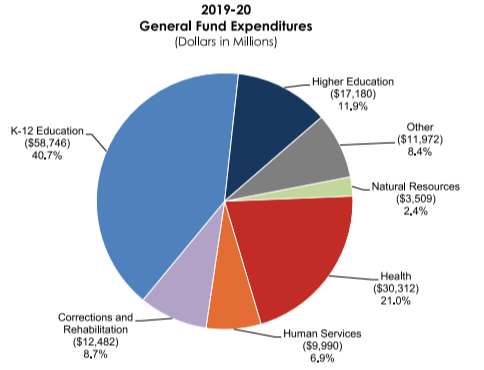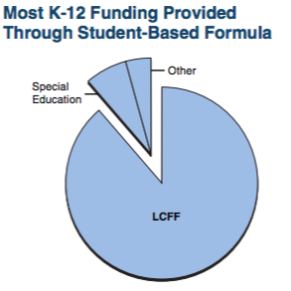As originally published in Ed100
We Squeezed the California Education Budget Process into One Short Blog Post!
Every year, California creates a budget for public education. How does that work, actually? Who creates and influences it, and when are the decisions made? How can you get involved and have an influence?
The Basics
Let’s start with the basics: How much $$ does education get in the state budget?
In January, the governor of California proposes a budget for the state. Education’s minimum share of the money is determined by a formula known as Prop 98. The formula includes many factors, including how well the economy is doing, whether there are more or fewer kids in public school, and changes in the cost of living. The education budget ends up about 40% of the general fund. (Some say there are only about three people in the whole state who really understand how the formula works.)
The state rarely allocates any more to education than the minimum required by law. So it would be good news for education if the education share of the budget is more than that minimum amount. Good budget years are good for public education, and the reverse is also true. (For more see Ed100 Lesson 8.3).
How is the education share of the budget divided?
Most of the money for K-12 education goes directly to school districts based on the number and characteristics of students who show up to school. Those rules — collectively known as the Local Control Funding Formula (LCFF) — define how the slice of the pie is divvied up. Unless the pie grows larger, increasing the LCFF portion means taking money from the other small portion of that pie. It’s really a zero-sum thing.
The Budget Process
Here is the big picture: There are hearings throughout the first half of the year that look at both the budget itself and at the budget impact of education bills. Each of these pathways is a little different. (The nonprofit California Budget & Policy Center does a great job of explaining the distinction between these two paths.)
By January 10, the Governor officially kicks off the budget process by proposing a budget with support from the state Department of Finance. Budget committees in the Senate and Assembly consider the Governor’s proposed budget as a whole. Subcommittees in the Senateand Assembly separately examine the proposed budget for education. These hearings are open to the public. When agendas are set, you can find them online.
After the Governor releases the proposed budget, advocates react, shoring up support for the parts they favor and scrambling to make adjustments.
Want more detail? Here’s an official flowchart
By May 14, the Governor releases a revised budget that reflects input and more up-to-date financial information. (You guessed it, it’s called the May Revise). If there has been a big change in the economy, the Governor’s revision may reflect it. Separately, the Budget Committees of the Senate and Assembly also each adopt their version of the budget. A conference committee irons out differences between these versions.
By June 15, the Senate and Assembly leaders huddle with the Governor to hash out the final details and pass a balanced budget by a majority vote of both houses. If the process gets stuck and they don’t pass a budget on time, legislators are not paid, based on an initiative passed in 2010 after a series of budget delays.
On July 1, the state begins the new fiscal year. Between the passage of the budget by the legislature and July 1 the Governor may cut specific expenditures using line-item vetos. This is rare.
Education Policy Bills: A Parallel Process
At the same time as the main budget bills are in the works, the Senate Education and Assembly Education committees consider policy billsthat affect education. Some policy bills approved by these committees involve money. If a bill requires significant money, it must survive passage through the Senate Appropriations or the Assembly Appropriations Committee. Many bills die in these committees because the cost is too high.
While the budget bill is adopted by July 1, education policy bills continue the legislative process through the summer. Similar to the federal process, after a bill passes one house, it must then go to the other for consideration. (The adopted budget may be revised a bit, with the Governor’s approval, to include funding in these adopted bills.)
Legislation is often a multi year process. If a bill fails at first, it may have set the stage for further discussion of the issue the next year.
How You Can Get Involved
That’s why you are reading this, right? You want to know how you can get informed and have some say in the budget process.
Get Informed. Throughout the development of the budget, the Legislative Analyst’s Office provides detailed information and analysis. You can sign up to be notified whenever there is a new report. Separately, the California Department of Finance offers information on the current Governor’s budget, as well as budget information from past years.
As bills work their way through the legislative process, you can find information about them on the state’s “Leg Info” page (it’s pronounced “ledge info”).
We are all in this together with you. We want to be a resource for you and for all of the children you love. Whether you need some info or you have info to share, you know where to go…LA Comadre.
Latest posts by La Comadre (see all)
- Cómo está Regresando la Escuela de un Salón - July 28, 2022
- ¿Se Debe Exigir a los Estudiantes recitar el Juramento a la Bandera? - June 10, 2022
- 5 Aplicaciones de Salud Mental y Bienestar para descargar ahora Mismo - May 5, 2022
- How the One Room Schoolhouse Is Making a Comeback - May 5, 2022
- El Dinero Importa: Donación de $ 1 millón a Programas de Educación Financiera en LAUSD - April 25, 2022



